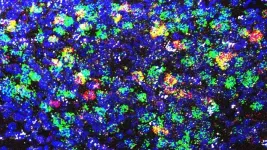(Press-News.org) An exoplanet infamous for its deadly weather has been hiding another bizarre feature—it reeks of rotten eggs, according to a new Johns Hopkins University study of data from the James Webb Space Telescope.
The atmosphere of HD 189733 b, a Jupiter-sized gas giant, has trace amounts of hydrogen sulfide, a molecule that not only gives off a stench but also offers scientists new clues about how sulfur, a building block of planets, might influence the insides and atmospheres of gas worlds beyond the solar system.
The findings are published today in Nature.
“Hydrogen sulfide is a major molecule that we didn’t know was there. We predicted it would be, and we know it’s in Jupiter, but we hadn’t really detected it outside the solar system,” said Guangwei Fu, an astrophysicist at Johns Hopkins who led the research. “We’re not looking for life on this planet because it’s way too hot, but finding hydrogen sulfide is a stepping stone for finding this molecule on other planets and gaining more understanding of how different types of planets form.”
In addition to detecting hydrogen sulfide and measuring overall sulfur in HD 189733 b’s atmosphere, Fu’s team precisely measured the main sources of the planet’s oxygen and carbon—water, carbon dioxide, and carbon monoxide.
“Sulfur is a vital element for building more complex molecules, and—like carbon, nitrogen, oxygen, and phosphate—scientists need to study it more to fully understand how planets are made and what they’re made of,” Fu said.
At only 64 light-years from Earth, HD 189733 b is the nearest “hot Jupiter” astronomers can observe passing in front of its star, making it a benchmark planet for detailed studies of exoplanetary atmospheres since its discovery in 2005, Fu said.
The planet is about 13 times closer to its star than Mercury is to the sun and takes only about two Earth days to complete an orbit. It has scorching temperatures of 1,700 degrees Fahrenheit and is notorious for vicious weather, including raining glass that blows sideways on winds of 5,000 mph.
As it did by detecting water, carbon dioxide, methane, and other critical molecules in other exoplanets, Webb gives scientists yet another new tool to track hydrogen sulfide and measure sulfur in gas planets outside the solar system.
“Say we study another 100 hot Jupiters and they're all sulfur enhanced. What does that mean about how they were born and how they form differently compared to our own Jupiter?” Fu said.
The new data also ruled out the presence of methane in HD 189733 b with unprecedented precision and infrared wavelength observations from the Webb telescope, countering previous claims about that molecule’s abundance in the atmosphere.
“We had been thinking this planet was too hot to have high concentrations of methane, and now we know that it doesn’t,” Fu said.
The team also measured levels of heavy metals like those on Jupiter, a finding that could help scientists answer questions about how a planet’s metallicity correlates to its mass, Fu said.
Less-massive giant icy planets like Neptune and Uranus contain more metals than those found in gas giants like Jupiter and Saturn, the largest planets in the solar system. The higher metallicities suggest Neptune and Uranus accumulated more ice, rock, and other heavy elements relative to gases like hydrogen and helium during early periods of formation. Scientists are testing whether that correlation also holds true for exoplanets, Fu said.
“This Jupiter-mass planet is very close to Earth and has been very well studied. Now we have this new measurement to show that indeed the metal concentrations it has provide a very important anchor point to this study of how a planet’s composition varies with its mass and radius,” Fu said. “The findings support our understanding of how planets form through creating more solid material after initial core formation and then are naturally enhanced with heavy metals.”
In coming months, Fu’s team plans to track sulfur in more exoplanets and figure out how high levels of that compound might influence how close they form near their parent stars.
“We want to know how these kinds of planets got there, and understanding their atmospheric composition will help us answer that question,” Fu said.
This research was supported by NASA through the JWST GO program.
Other authors are Luis Welbanks, Dana R. Louie, and Michael Line of Arizona State University; Drake Deming, Jegug Ih, Arjun B. Savel, Eliza M.-R. Kempton, and Matt Nixon of University of Maryland; Julie Inglis and Heather A. Knutson of California Institute of Technology; Michael Zhang of University of Chicago; Joshua Lothringer of Utah Valley University; Julianne I. Moses and Gregory Henry of Tennessee State University; Everett Schlawin of University of Arizona; David K. Sing of Johns Hopkins; and Thomas Greene of NASA Ames Research Center.
END
Stench of a gas giant? Nearby exoplanet reeks of rotten eggs. And that’s a good thing
Astronomers sniffed out the stinky atmosphere with Webb Telescope
2024-07-08
ELSE PRESS RELEASES FROM THIS DATE:
Study backs RSV vaccine safety during pregnancy
2024-07-08
Vaccinating mothers against respiratory syncytial virus (RSV) during late pregnancy to protect their newborns is not associated with an increased risk of preterm birth or other poor outcomes, according to a study by Weill Cornell Medicine and NewYork-Presbyterian investigators. Infants are particularly vulnerable to the virus which can cause a serious lower respiratory illness.
The study published in JAMA Network Open on July 8 adds real-world evidence to the existing data from clinical trials about the safety of Pfizer’s Abrysvo vaccine. The researchers found that there ...
Brigham study finds new program streamlined hospice transitions from the emergency department
2024-07-08
KEY TAKEAWAYS
After implementing a new hospice transition program, 210 out of 388 patients (54.1 percent) at Brigham and Women’s Hospital transitioned to hospice from the emergency department (ED) within 96 hours, compared to 61 of 270 patients (22.1 percent) in the control period.
Across all groups, the presence of a Medical Order for Life-Sustaining Treatment plan (MOLST), was independently associated with hospice transition.
These findings suggest that hospice transition programs can help improve use of hospice for patients presenting at the ED near the end ...
Diet quality among children
2024-07-08
About The Study: Although total dietary quality scores among U.S. children improved overall during 2005-2020, the increase remained suboptimal: lower than 5 points, a significant threshold for children in this analysis of changes in diet quality.
Corresponding Author: To contact the corresponding author, Yongjun Zhang, Ph.D., M.D., email zhangyongjun@sjtu.edu.cn.
To access the embargoed study: Visit our For The Media website at this link https://media.jamanetwork.com/
(doi:10.1001/jamapediatrics.2024.1880)
Editor’s Note: Please see the article for additional information, ...
Acceptability of hospital-at-home care and capacity for caregiver burden
2024-07-08
About The Study: Survey respondents reported substantial acceptability of hospital-at-home care, which did not vary across sociodemographics, health insurance coverage, health status, prior hospitalizations, or telehealth use. Approximately half of respondents agreed that hospital-at-home care was effective, safe, and convenient. Most indicated capacity to perform many caregiver tasks.
Corresponding Author: To contact the corresponding author, Melissa A. Frasco, Ph.D., email mfrasco@usc.edu.
To access the embargoed ...
Semaglutide vs tirzepatide for weight loss in adults with overweight or obesity
2024-07-08
About The Study: In this population of adults with overweight or obesity, use of tirzepatide was associated with significantly greater weight loss than semaglutide. Future study is needed to understand differences in other important outcomes.
Corresponding Author: To contact the corresponding author, Nicholas L. Stucky, M.D., email nicholass@truveta.com.
To access the embargoed study: Visit our For The Media website at this link https://media.jamanetwork.com/
(doi:10.1001/jamainternmed.2024.2525)
Editor’s Note: Please see the article for additional information, including other authors, author contributions and affiliations, conflict of interest ...
AJPH study shows that permit to purchase laws are a promising avenue to reduce suicides in young adults
2024-07-08
In 2020, suicide ranked as the third leading cause of death for adults aged 18 to 20 years in the United States. Firearms were implicated in approximately half of these cases, and by 2017, they had surpassed motor vehicles as the leading cause of death in this age group. While ongoing debates on gun violence and mental health have increased public support for restricted firearm access, not much is known about the impact of gun control policies on young adults.
To fill this knowledge gap, a recent study published in the August issue of the American Journal of Public Health on July 03, ...
Companies that mitigate climate change reduce their cost of capital
2024-07-08
Fukuoka, Japan —The climate crisis is hitting home with more frequent extreme weather events. Companies, particularly those in high-emission industries, are major contributors to global carbon emissions, therefore making them key players in the fight against climate change. Recognizing this responsibility, many businesses are now taking proactive measures to reduce their carbon footprint, by reducing carbon emissions and transparently sharing their environmental strategies and data.
The Task Force on Climate-Related Financial Disclosures ...
Case Western Reserve University receives $1.5M grant from Foundation Fighting Blindness to test possible new treatment for inherited retinal disease
2024-07-08
CLEVELAND—There’s only one U.S. Food and Drug Administration-approved therapy for an inherited retinal disease, and dozens of retinitis pigmentosa (RP) genes for which no therapy is available.
With a new three-year, $1.5 million grant from the Foundation Fighting Blindness, Shigemi Matsuyama, an associate professor of ophthalmology and visual sciences at the Case Western Reserve University School of Medicine, will test a possible breakthrough drug that can be taken by mouth—one that may address many RP disease manifestations, regardless of the underlying genetic mutation.
“We believe it can serve as the basis of an oral medicine to prevent blindness in RP ...
How to stop cancer cachexia? Start at the top
2024-07-08
Cancer is insidious. Throughout tumor progression, the disease hijacks otherwise healthy biological processes—like the body’s immune response—to grow and spread. When tumors elevate levels of an immune system molecule called Interleukin-6 (IL-6), it can cause severe brain dysfunction. In about 50%-80% of cancer patients, this leads to a lethal wasting disease called cachexia. “It’s a very severe syndrome,” says Cold Spring Harbor Laboratory (CSHL) Professor Bo Li.
“Most people with cancer die of cachexia instead of cancer. And once the patient enters this stage, there’s ...
Pulsed field ablation procedures found safe and effective for atrial fibrillation patients
2024-07-08
Pulsed field ablation (PFA) is safe for treating patients with common types of atrial fibrillation (AF), according to the largest study of its kind on this new technology, led by the Icahn School of Medicine at Mount Sinai.
The “MANIFEST-17K” international study is the first to show important safety outcomes in a large patient population, including no significant risk of esophageal damage, with PFA. PFA is the latest ablation modality approved by the Food and Drug Administration that can be used to restore a regular heartbeat. The findings, published July 8 in Nature Medicine, could lead to more frequent use of PFA instead of conventional therapies to manage AF patients.
“MANIEFST-17K ...
LAST 30 PRESS RELEASES:
Statins significantly reduce mortality risk for adults with diabetes, regardless of cardiovascular risk
Brain immune cells may drive more damage in females than males with Alzheimer’s
Evidence-based recommendations empower clinicians to manage epilepsy in pregnancy
Fungus turns bark beetles’ defenses against them
There are new antivirals being tested for herpesviruses. Scientists now know how they work
CDI scientist, colleagues author review of global burden of fungus Candida auris
How does stroke influence speech comprehension?
B cells transiently unlock their plasticity, risking lymphoma development
Advanced AI dodel predicts spoken language outcomes in deaf children after cochlear implants
Multimodal imaging-based cerebral blood flow prediction model development in simulated microgravity
Accelerated streaming subgraph matching framework is faster, more robust, and scalable
Gestational diabetes rose every year in the US since 2016
OHSU researchers find breast cancer drug boosts leukemia treatment
Fear and medical misinformation regarding risk of progression or recurrence among patients with breast cancer
Glucagonlike peptide-1 receptor agonists and asthma risk in adolescents with obesity
Reviving dormant immunity: Millimeter waves reprogram the immunosuppressive microenvironment to potentiate immunotherapy without obvious side effects
Safety decision-making for autonomous vehicles integrating passenger physiological states by fNIRS
Fires could emit more air pollution than previously estimated
A new way to map how cells choose their fate
Numbers in our sights affect how we perceive space
SIMJ announces global collaborative book project in commemoration of its 75th anniversary
Air pollution exposure and birth weight
Obstructive sleep apnea risk and mental health conditions among older adults
How talking slows eye movements behind the wheel
The Ceramic Society of Japan’s Oxoate Ceramics Research Association launches new international book project
Heart-brain connection: international study reveals the role of the vagus nerve in keeping the heart young
Researchers identify Rb1 as a predictive biomarker for a new therapeutic strategy in some breast cancers
Survey reveals ethical gaps slowing AI adoption in pediatric surgery
Stimulant ADHD medications work differently than thought
AI overestimates how smart people are, according to HSE economists
[Press-News.org] Stench of a gas giant? Nearby exoplanet reeks of rotten eggs. And that’s a good thingAstronomers sniffed out the stinky atmosphere with Webb Telescope






